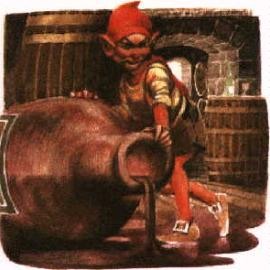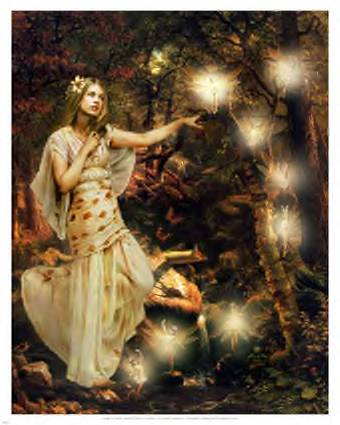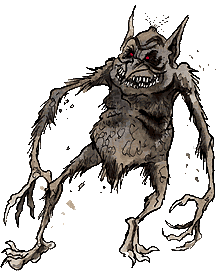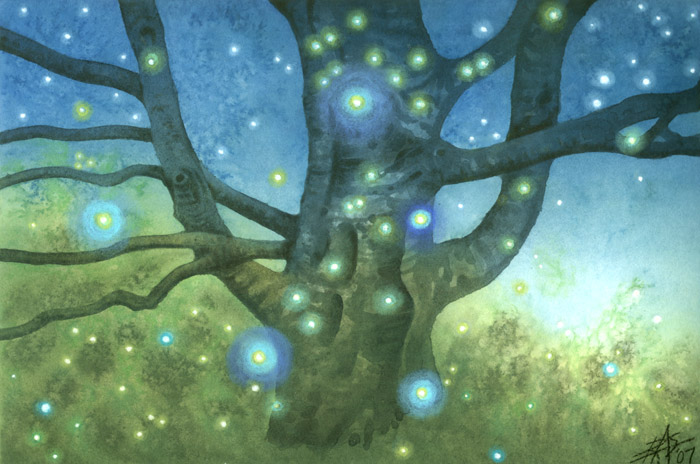
When you hear the word "fairy", what is the first image that pops into your mind? Tinkerbell? The Tooth Fairy? Maybe Cinderella's beloved Fairy Godmother? In the past fifty years, fairies have been commercialized and cartoonized, but believe it or not…the actual belief in fairies has been ongoing on earth for thousands of years…if not longer. Before Tinkerbell and her fairy cohorts, from the ancient times to modern times, Europe has carried a lasting imprint of fairy legends including the Bean Sidhe of Ireland, the dryads and the Oak King in the ancient Celtic countries, giants and ogres in England, and the moniciello in Italy. Let me introduce and intrigue you with some of the oldest, and sometimes hauntingly familiar, lore of the Fairy folk from ancient to modern-day Europe.
Fairies in Western Europe
Ireland:
You are an Irish warrior, returning to your home in County Clare, after a long and arduous battle. You are walking down that old familiar, winding path that leads to the river. As the calm river slowly appears to your weary eyes, you notice a tall, ghostly woman bent over the river's edge. It looks as though she is washing something in the river. You move in just a bit closer to get a look at what important chore she is performing, when she looks up at you abruptly with large, haunting yet beautiful eyes. She lets out a wail, so shrill and ear piercing that you take off running passed the river's edge and into the dark, yet comforting forest that leads to your home's farmland. Who was this ghost of a woman? Why did she scream so suddenly and what was she washing in the river?
This ghostly figure has been seen throughout Ireland for centuries, maybe even millennia. Her name is the Bean Sidhe (pronounced ban-shee) and many have speculated that she is a type of fairy that still inhabits Ireland. She has other names throughout Ireland, and has also been seen and heard in Scotland and England. Her other names include Washer at the Ford and Washer of the Shrouds. The legends tell that the Bean Sidhe has been heard and more rarely seen immediately before a death in one of the first Irish noble families. It has been said that there is more than one Bean Sidhe and each of these ghostly fairies seem to be attached to certain Irish noble families. Whenever she has been seen, her appearance gives off a haunting glow and it looks as though she was pulled out of a mossy grave. Some claim she resembles an old hag with long, stringy hair, while others say she is the ghost of a beautiful noblewoman who died during childbirth. However, she looks…she is best known for her mourning wail. There are many stories that depict how the Bean Sidhe's wail sounds; however, just as perception differs from person to person…so does the sound of the Bean Sidhe. One thing is for sure…I would not want to run into this fairy myself!

A close relative of the well-known leprechaun is the clurichaun. Are you in need of a fairy to guard your wine cellar or vineyard? The clurichaun may be the right fairy to employ. For hundreds of years, the clurichaun has been said to guard wine cellars of those in Ireland who are fair and hospitable to others. He looks quite similar to his cousin, the leprechaun, but is usually seen wearing red instead of green and is almost always innebriated. Those who have had the comical pleasure of having a clurichaun guard their cellar say that he can be heard singing old Irish tales and fables. But take heed…if this fairy finds out you have been unfair or unkind to a passer-by, he will wreak havoc upon your wine stock, and leave your cellar to never return.

Another type of Irish fairy that has quite an enchanting and riveting story is the Dinnshencha (pronounced Din-sheen-k'ha). This fairy has appeared in a dwarfish size and were told to have the ability of shapeshifting into any form in order to avenge battered or harmed women. These fairies are almost helper-bees, if you will, for the ancient cattle Goddess Aine. Aine was a woman who was raped by a Connacht King in ancient times and deified to bestow guardianship over wronged women throughout Ireland. Some say they can still see her in her earliest form roaming the fields with the cattle, waiting to pierce the heart of any Irish woman's tormenter.

Ballybogs have been told throughout the years in Ireland to be the fairy protectors of the gloomy peat bogs. The fairy race of the Ballybogs are usually covered in globs of mud and they possess ugly, round bodies. The ballybog is not the prettiest fairy to meet in passing, but he serves his life's purpose for a noble cause…he guards the ancient peat bogs of Ireland. It has been speculated that some of the mummified bodies found in Ireland's peat bogs were placed there as human sacrifice to appease the ballybog fairies of ancient times.

Some of the Irish folk still say that if you sit in the quiet, green forests at midnight until just before dawn, you may catch a quick glimpse of a fairy known as a Dryad. A Dryad is a tree spirit, usually found in the highest boughs of the Irish trees, although the dryads were thought to inhabit all of trees in all of the Celtic countries at one point in time. The mythical dryads were the basis of the Druidic order of the Celts. The druidic order were a religious group of priests and priestesses that inherited their knowledge of the other world from the Dryad fairies that lived in the thirteen sacred Celtic trees (although willow trees are the most common place to spot a dryad). Interestingly, there is a reference to dryads within C.S. Lewis' Chronicles of Narnia, more specifically The Lion, The Witch, and the Wardrobe.
Scotland:
If you are in need of an extra pair of hands around the house, mind your P's and Q's and you may just attract the assistance of a fairy known as a brownie. The legend of the Scottish brownie is one that has migrated to the U.S. and Canada with the Scottish immigrants. The fairy legends claim that brownies are small, drawf-like fairies that choose a hard-working family (one that is kind and good-hearted, overall) to abide with and assist in daily chores and farm duties. The brownies particularly dwell in warm homes and do not fancy the domesticated cat. I could use an extra pair of hands and unfortunately that means my house is out of the picture. Brownies are the type of fairy that are able to shape-shift, if they are old enough and wise enough to know the technique. These fairies have been told to shape-shift into roosters so that they can assist a farm throughout the day…because in their truest form they are too sensitive to sunlight. The sunlight is why most people will never lay an eye on a brownie in it's true form. If you are a liar, a cheat, or a clergyman…you will never have the wonderful experience of housing and employing the very helpful brownie fairy. Why is this? Because the brownie fairies hate liars, cheats, and especially hypocritical ministers.

The well-known fairy tales of the Seelie Court and it's paradox, the Unseelie Court, have been passed down through the Scottish families probably since the Dark Ages. These two groups of fairies are parallel opposites of each other; however, one would most likely not exist without the other…kind of like a ying/yang situation. The fairies that make up the Seelie Court were benevolent to the Scottish people, riding on the winds and gazing down at Scotland to find some sort of good deed to perform. It has been said that these heroic fairies have aided the kind-hearted Scottish folk in their most desparate times of need. The Unseelie Court acts as the antagonist in this age-old story. These fairies were known to be malicious and ride on the highest winds of the greatest storms, waging war against the good Seelie Court fairies. You could probably travel to Scotland today and hear tales of the Seelie and Unseelie Courts' battles in the heavens.
England:
The sun is quickly setting and you are setting the table for dinner in your small English cottage. You hear the thumping of a horse's hooves on the outside street…except it sounds like the horse has but two hooves. You quickly run out your front door to inspect the outside surroundings and you see to your amazement and disgust a hairy and large horse…galloping through the town on his hind legs. How is this possible? Well, this fairy was known as The Grant, and he has the ability (like a human being) to walk and run on his hind legs. This is quite a sight to behold and scared most English townsfolk when they did catch a glimpse of this hideous fairy in the Middle Ages; however, The Grant's presence was merely to warn the town of an oncoming enemy or catastrophe. We can assume that he was a good-natured fairy, although somewhat appalling in the area of appearances. He was known to run through towns and stir up the town's dogs and horses, also as a means of warning the good townsfolk.

Willowisps are fairies that have also been called Elf Fire, Night Whisperers, and Bob-a-longs. They appear as orbs of light, flickering and bobbing along in the distant meadows or shorelines. Willowisps are supposedly a beautiful, radiating sight and have inspired many artists in centuries past. Sightings of the willowisps are still reported today, though most people who see them do not recognize them as faires but as some other creature…aliens or ghosts, possibly. I am by no means discrediting the belief in aliens or ghosts but is it not possible that some of the alien and ghost sightings could have been mistaken sightings of willowisps? It is just a theory.
Fairies in the Mediterranean Region
Italy is a place where magic abounds. If you have ever travelled to Italy, I am sure you have felt it's magic the moment you stepped onto it's enchanting land. I have never been there myself, but I do feel a yearning to visit this Mediterranean beauty.
One endearing and old Italian tale is that of the Monaciello…a fairy that resembles that of a tiny monk. This tiny monk is almost the Italian combination of the Irish clurichaun and leprechaun in that the Monaciello guards wine cellars but also guards a treasure. This treasure, it has been told, can only be acquired by stealing the Monaciello's cloak. Unfortunately, if you decide to steal this little monk's cloak…he will eventually die, as his energy is tied directly to his robes.

A not-so-endearing and dark Italian tale speaks of the Orculli, a malevolent and cannibalistic fairy that inhabits the tops of clouds over Italy's farmland and waterways. They leave their homes only to grab a passing fairy or human to consume, if their own kind is harder to catch for dinner. The name "Orculli" is one that reminds me of the "orcs" in JRR Tolkien's Lord of the Rings trilogy. This fictional character and the Italian fairy seem to bear resemblences in their temperaments and nutritional habits, as well.
If you take a journey to Greece, the belief in fairies and gods was widely prevalent in ancient times through the fall of the Roman Empire. These beliefs have been revived by the neopagans today that incorporate the Greek pantheon into their ceremonies. Two types of fairies that are at the fore-front of these ceremonies are the Sylphs and the Undines.
The Sylphs are archetypal representatives of the element Air and reside in the East. These fairies are human-like but very tiny and bear wings…if they are to represent the element Air what good would they be if they couldn't fly? They are also known as the Air Watchtowers or Windsingers.
The Undines are archetypal represenatatives of the element Water and reside in the South. They appear as seahorse-like creatures but posses human qualities in their faces. When the Romans adopted the Greek pantheon into their culture, they adopted the belief in the Undines and eventually deified these fairies as demigods.

http://kittythedreamer.hubpages.com/hub/Faeries-Legends-and-Myths-from-Around-the-World

Very nice!
Hu Father of the Fae?
"Curiously enough, the name 'HU' also occurs in the Celtic myth of Hu Gadam, an Atlantean person from the sea who guided a band of settlers to the prehistoric shores of Wales. There is also an uncanny similarity of sound between the names Hu Gadam and the Tuatha de Danaans (pronounced Tuar-de-Danans), those strange fairy people with magical powers who, according to legend, landed on the shores of prehistoric Ireland" (p. 197) – The Sirius Connection – Murray Hope
""Their temples wherein the sacred fire was preserved were generally situate on eminences and in dense groves of oak, because a circle was the emblem of the universe; oval, in allusion to the mundane egg, from which issued, according to the traditions of many nations, the universe, or, according to others our first parents; serpentine, because a serpent was the symbol of HU, the Druidic Osiris; cruciform because a cross is an emblem of regeneration; or winged, to represent the motion of the divine spirit.*** Their chief deities were reducible to two – a male and a female, the great father and mother – HU and Cridwen, distinguished by the same characteristics as belong to Osiris and Isis, Bacchus and Ceres, or any other supreme goddess representing the two principles of all Being."
"Godfrey Higgins states that HU, the Mighty, regarded as the first settler of Britain, came from a place which the Welsh Triads call the summer country, the present site of Constantinople. Albert Pike says that the Lost Word of Masonry is concealed in the name of the Druid god HU. The meager information extant concerning the secret initiations of the Druids indicates a decided similarity between their Mystery school and the schools of Greece and Egypt. HU, the sun God, was murdered and, after a number of ordeals and mystic rituals, was restored to life." – The Secret Teachings of All Ages – Manly P. Hall
"And that which came to meet the soul (as light and sound come to meet our outer eyes and ears) was called HU, the spiritual world." (p. 137)
"The God HU was the all-ruling Divinity of Western Celtic mythology. He represented the power and the glory of the spiritual world." (p. 153)
"The Mysteries of HU revealed the other pole of human life: the ascent out of the body into the 'glorified' state of expansion of the consciousness in the spiritual world." (p. 153)
"And HU could bring music to the consciousness of waking man and teach it to him, because he himself could hear in sleep the harmonies of the spheres, and his passage from waking to sleeping to waking was unbroken by any obliteration of consciousness. This was always the summit of initiation experience." (p. 165) – The Flaming Door: Mission of the Celtic Fold Soul – Eleanor C. Merry
GRAND!
Thanks everyone for commenting on my blog!